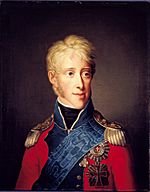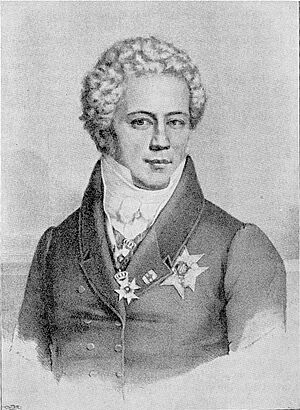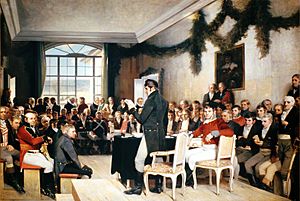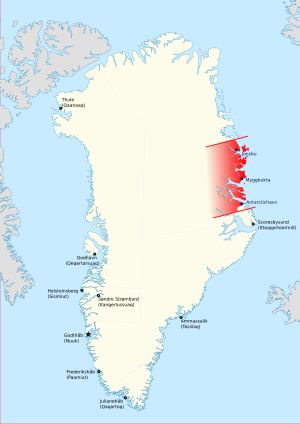Treaty of Kiel facts for kids
| Kieltraktaten (Danish) Freden i Kiel (Swedish) |
|
|---|---|
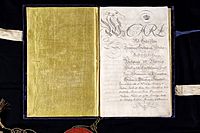
Translated reprint of the part concerned with Norway
|
|
| Type | Peace treaty |
| Context | War of the Sixth Coalition during the Napoleonic Wars |
| Signed | 14 January 1814 |
| Location | Kiel, Duchy of Holstein |
| Parties | |
| Language | French |
The Treaty of Kiel was a peace agreement signed on January 14, 1814, in Kiel, Germany. It officially ended the fighting between the United Kingdom and Sweden on one side, and Denmark-Norway on the other. This happened during the Napoleonic Wars, a huge conflict across Europe. The United Kingdom and Sweden were fighting against France, while Denmark-Norway was allied with France.
Under this treaty, Frederick VI of Denmark joined the side against France. He gave the island of Heligoland to the British King. More importantly, he gave the Kingdom of Norway to King Charles XIII of Sweden. In return, Denmark received Swedish Pomerania, a region in northern Europe. However, some parts of Norway, like Greenland, Iceland, and the Faroe Islands, stayed with Denmark.
Not everything in the treaty happened as planned. Norway decided to declare its independence. They wrote their own constitution and chose Crown Prince Christian Frederik as their king. Because of this, Sweden did not give Swedish Pomerania to Denmark. Instead, it went to Prussia after a big meeting called the Congress of Vienna in 1815. After a short war with Sweden, Norway agreed to join a personal union with Sweden. King Christian Frederik stepped down, and the Norwegian parliament (called the Storting) changed the constitution. On November 4, 1814, the Storting elected Charles XIII as the King of Norway, officially forming the union.
Contents
Why the Treaty of Kiel Happened
In the early days of the Napoleonic Wars, both Denmark-Norway and Sweden tried to stay neutral. But soon, they were pulled into the conflict on opposite sides. In 1805, the Swedish king, Gustav IV Adolf, joined an alliance with the United Kingdom and Russia against Napoleon Bonaparte.
Denmark-Norway, however, became an ally of France. This happened after the British attacked Copenhagen in 1807. In 1812, Napoleon's army was badly defeated in Russia. Sweden then joined the alliance against Napoleon. Sweden's condition for joining was to gain Norway. The United Kingdom and Russia agreed to this in May 1813.

Denmark, still allied with Napoleon, became isolated and faced financial problems. After Napoleon's defeat in October 1813, the Swedish Crown Prince Jean Baptiste Bernadotte attacked Denmark. He quickly defeated the Danish army and occupied parts of Denmark. To avoid further invasion, Frederick VI of Denmark agreed to make peace, leading to the Treaty of Kiel.
Agreements with the United Kingdom
The treaty between Denmark and the United Kingdom had 14 articles. It was negotiated by Danish diplomat Edmund Bourke and British envoy Edward Thornton.
- The United Kingdom agreed to return all Danish lands they had taken, except for the island of Heligoland. This island became fully British.
- The Danish king agreed to join the alliance against Napoleon. He promised to provide an army of 10,000 soldiers to fight alongside the Allied forces.
- The treaty also mentioned ending the slave trade.
- The British king promised to help Denmark get more compensation for giving Norway to Sweden in a future peace agreement.
Agreements with Sweden
The treaty between Denmark and Sweden had 28 articles. It was negotiated by Danish diplomat Edmund Bourke and Swedish envoy Baron Gustaf af Wetterstedt.
- The Danish king officially gave up all claims to the Kingdom of Norway "forever" to the Swedish king. This included major Norwegian regions and coastal islands.
- However, Greenland, Iceland, and the Faroe Islands were specifically excluded and remained with Denmark.
- Sweden agreed to take over Norway's debts and financial responsibilities.
- In return, Swedish Pomerania was supposed to be given to Denmark.
- The Swedish king promised to ensure that Norway's University in Christiania (now Oslo) would continue to operate.
- People living in the transferred territories could choose within six years whether to live in Norway or Denmark.
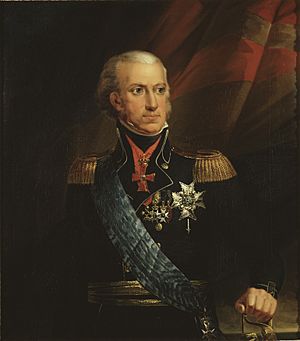
What Happened Next
The Union of Sweden and Norway
When Norwegians heard about the treaty, many were very upset. They had fought against the Swedes just five years before. A movement for independence had already started, and it grew stronger. Christian Frederik, the Danish Crown Prince and viceroy in Norway, saw an opportunity. He took charge of the Norwegian independence movement.
On April 10, 1814, a national assembly met at Eidsvoll to write a constitution. Norway declared its independence on May 17, 1814, and elected Christian Frederik as their king. This day, May 17, is now celebrated as Norwegian Constitution Day.
This led to a short war with Sweden. Sweden's army, fresh from fighting Napoleon, was too strong. However, during peace talks, the Swedish Crown Prince Bernadotte made an important promise. He accepted Norway's new constitution. This meant Norway would not just become a Swedish province. Under the Convention of Moss, Norway agreed to join a personal union with Sweden. After making changes to their constitution, the Norwegian Storting elected Charles XIII of Sweden as King of Norway on November 4, 1814.
Swedish Pomerania's Fate
Because Norway refused to become part of Sweden, Charles XIII of Sweden did not give Swedish Pomerania to Frederick VI of Denmark. The issue was resolved at the Congress of Vienna in 1815. A plan by Karl August von Hardenberg, the prime minister of Prussia, was followed.

- Prussia gave a region called East Frisia to Hanover.
- In return, Prussia received the Duchy of Lauenburg from Hanover.
- Prussia then gave the Duchy of Lauenburg to Denmark, along with a payment of 3.5 million talers.
- Prussia also took over a Danish debt to Sweden and paid Sweden more money.
- In exchange, Denmark and Sweden gave up their claims to Swedish Pomerania, which then went to Prussia.
- On October 23, 1815, Swedish Pomerania officially became part of Prussia.
The East Greenland Case
Many years later, between 1931 and 1933, Norway challenged Denmark's ownership of all of Greenland. This happened at the Permanent Court of International Justice in The Hague. It was the only time an international court decided who owned a polar territory.
Norway argued that Denmark only owned parts of Greenland where it had actual control. So, in July 1931, Norway claimed a part of eastern Greenland, calling it Eirik Raudes Land. However, on April 5, 1933, the court ruled that based on the Treaty of Kiel and other agreements, Denmark was the rightful owner of all of Greenland.
See also
- History of Denmark
- History of Norway
- Scandinavia
- Norway in 1814


